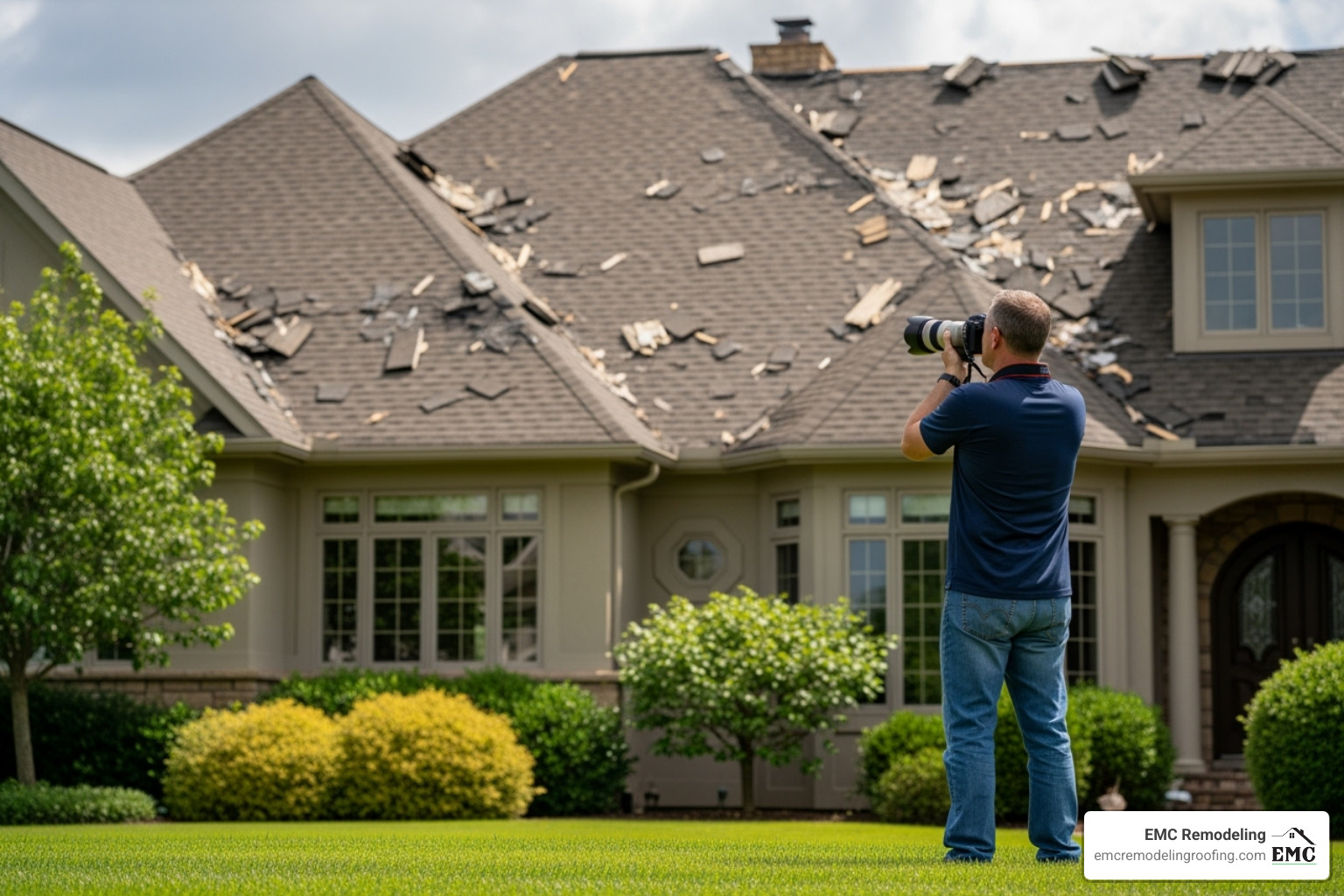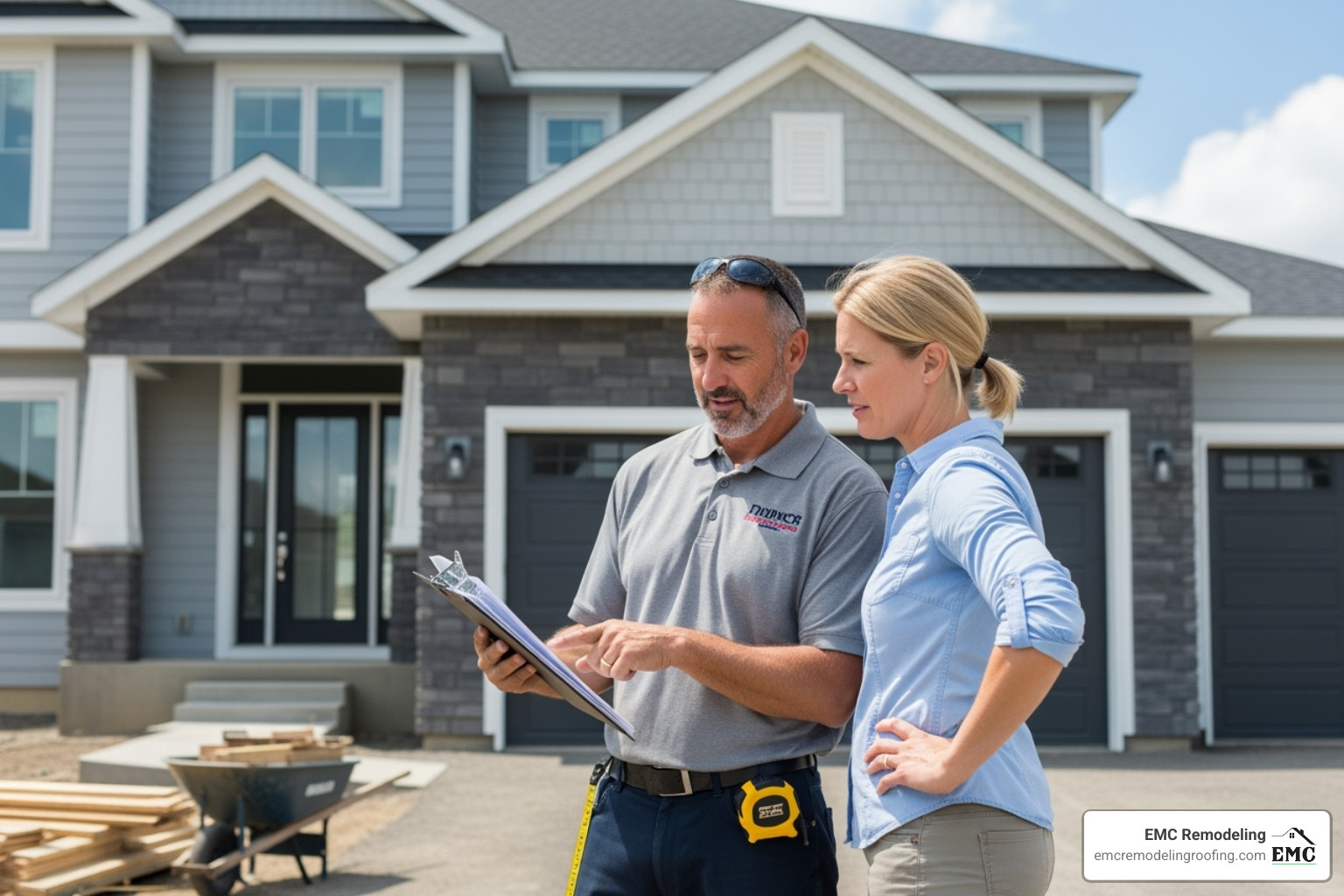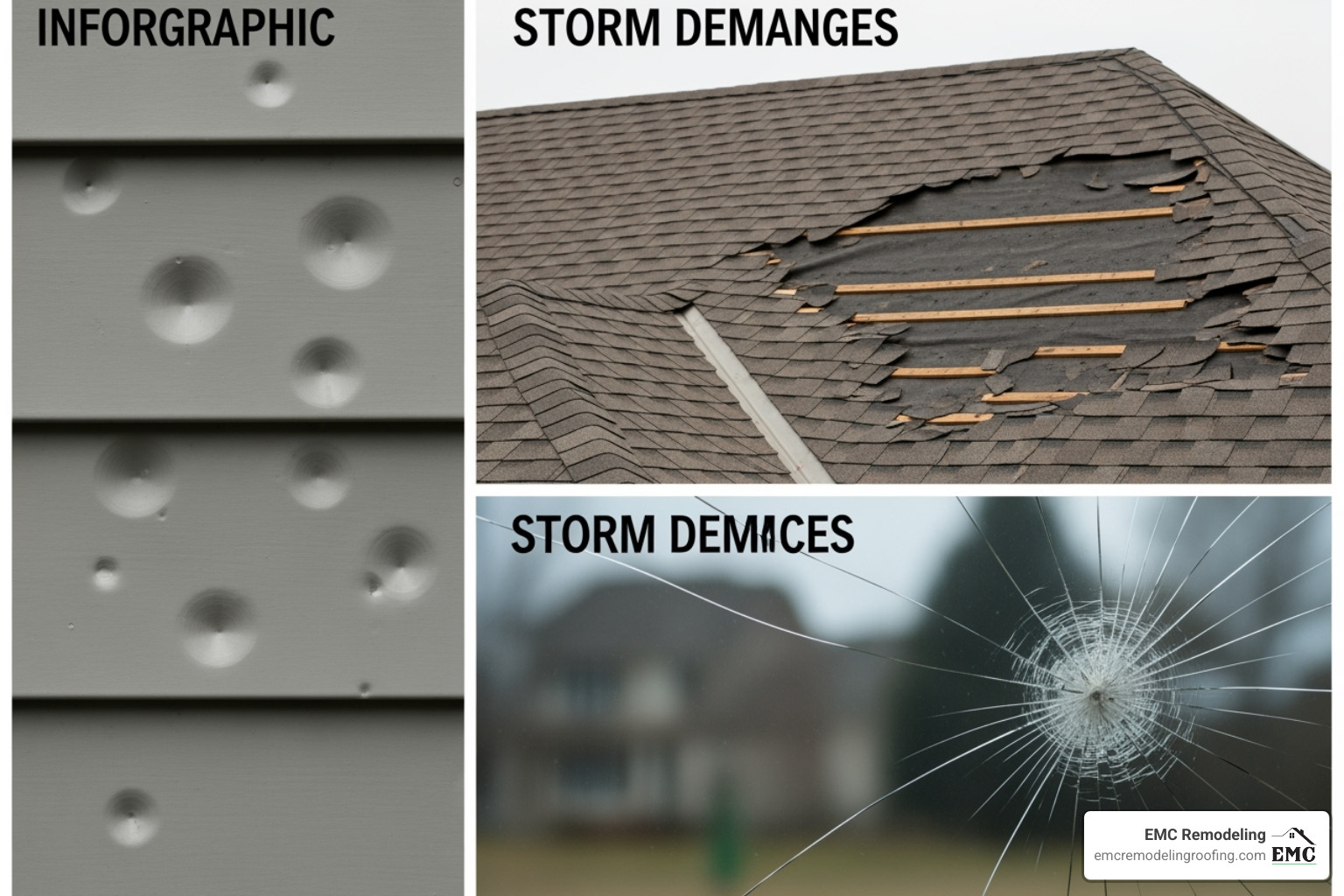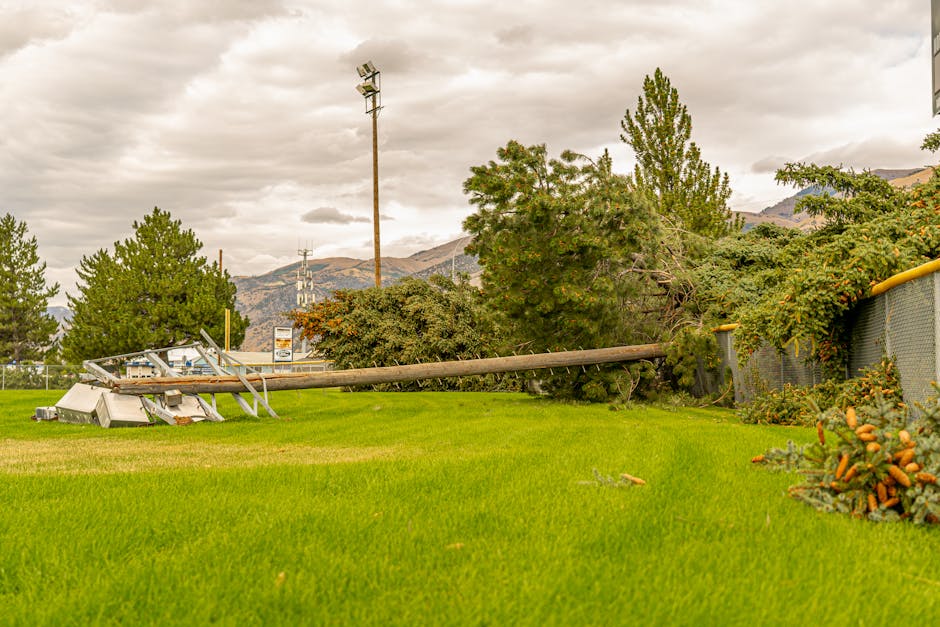The Urgency of Storm Damage Repair in Central Texas
Storm damage repair is a critical service that prevents minor issues from becoming costly disasters. When severe weather strikes Central Texas, acting fast protects your home and wallet. For comprehensive home restoration services, partnering with an experienced local contractor is key to a safe and efficient recovery.
Quick Action Steps After Storm Damage:
- Ensure Safety First – Stay away from downed power lines and unstable structures.
- Document Everything – Take photos and videos of all visible damage.
- Make Temporary Repairs – Tarp holes and board up windows if it’s safe.
- Contact Your Insurance – File your claim within 24-48 hours.
- Hire a Licensed Professional – Get quotes from reputable contractors.
The financial impact is staggering. In 2023, insured losses from severe weather topped $57.9 billion in the U.S. The average wind and hail claim is $5,000 to $10,000, a figure that can double if water damage leads to mold.
Central Texas faces unique threats like hailstorms and flash floods. Time is critical—water damage needs attention within 12-24 hours to stop mold. I’m Matt Runyon, President of EMC Remodeling & Roofing. With over 15 years of experience, my team and I help Central Texas homeowners steer storm damage repair with quality work and clear communication. We understand the urgency and work with your insurance to streamline the process.

Step 1: Prioritize Safety and Initial Assessment
After a storm, your first priority is safety. Once everyone is secure, you can begin a preliminary assessment. Avoid rushing onto damaged roofs or into unstable areas; storm damage repair starts with smart, safe decisions. Leave dangerous assessments to professionals with the right training and equipment.

Essential Safety Precautions After a Storm
Recognizing post-storm hazards can save your life. Here’s what to watch for:
- Downed Power Lines: Treat all downed lines as live. Stay at least 10 feet away and call 911 immediately.
- Gas Leaks: If you smell gas or hear hissing, evacuate immediately. Don’t use any electronics. Call your gas company and 911 from a safe distance.
- Broken Glass and Debris: Wear sturdy boots and work gloves to protect yourself from sharp objects.
- Structural Damage: Look for sagging ceilings, leaning walls, or jammed doors. If you suspect a collapse risk, stay out.
- Electrical Hazards: Standing water and electricity are a deadly mix. If your home has flooded, do not enter until a professional has shut off the main power.
- Use Flashlights: Use battery-powered flashlights, not open flames, to avoid igniting potential gas leaks.
For immediate protection against further water damage, consider Emergency Roof Patching. These temporary measures can prevent a small leak from becoming a major problem.
How to Assess and Document Property Damage
Thorough documentation is your financial lifeline for a smooth insurance claim. Prepared homeowners with clear evidence are more likely to receive a fair and prompt settlement.
- Photo and Video Evidence: Take wide shots of the overall scene and detailed close-ups of all damage. A narrated video walkthrough is also powerful evidence.
- Written Notes: Record the date and time of the storm, a description of the damage, and any immediate actions you took.
- Save Receipts: Keep all receipts for temporary repairs, lodging, or other storm-related expenses, as they may be reimbursable.
- Exterior Inspection: Check your roof, gutters, siding, windows, and fences for any signs of damage, like granule loss on shingles or dents in gutters.
- Interior Inspection: Look for water stains on ceilings and walls, damp carpets, or warped flooring, which can indicate hidden roof leaks. Your attic often reveals the true extent of roof damage.
For a complete evaluation, a professional Roof and Attic Inspection can identify hidden issues that could lead to major problems later.
Step 2: Navigating Insurance and Professional Repairs
After ensuring safety and documenting damage, the next step in storm damage repair is navigating insurance claims and hiring a contractor. With the average wind and hail claim exceeding $10,000, this process can feel overwhelming. However, with the right local partner, you can move from chaos to restoration smoothly.

Filing Your Insurance Claim: A Step-by-Step Process
Getting your insurance claim right from the start saves time and money.
- Contact Your Insurer Promptly: Call your insurance company within 24-48 hours of the storm. Early reporting often leads to faster processing.
- Review Your Policy: Understand your coverage, exclusions, and deductible. Deductibles in Central Texas are typically $500-$2,000 but can be higher for wind and hail.
- Beware Deductible Scams: Be wary of contractors offering to “cover your deductible.” This practice is illegal in Texas and a red flag for fraud.
- Meet the Adjuster: Be present for the adjuster’s meeting. Provide all your documentation and point out all the damage you’ve found.
- Keep Records: Maintain a detailed file of all communication, estimates, and paperwork related to your claim. Our Insurance Roof Claims resource offers more detailed guidance.
How to Choose a Trusted Storm Damage Repair Contractor
After a storm, “storm chasers” often appear, offering quick, cheap fixes. Choosing a reputable local contractor is your best defense against shoddy work.
- Check Local Reputation: Choose a contractor with deep roots in Central Texas. Check online reviews and ask for local references.
- Verify License and Insurance: Ensure your contractor is licensed in Texas and carries both general liability and workers’ compensation insurance.
- Look for Certifications: Industry certifications from organizations like the IICRC indicate a commitment to quality and ongoing training.
- Get Multiple Quotes: Compare several quotes, but focus on value, not just the lowest price. Analyze the scope of work, materials, and warranties offered.
- Insist on a Written Contract: A professional contract protects everyone by clearly outlining all project details, including costs, timelines, and materials.
- Avoid Red Flags: Steer clear of contractors who use high-pressure tactics, demand full payment upfront, or make offers that seem too good to be true.
Your Local Temple, TX Restoration Experts
When storm damage strikes Central Texas, you need a local partner. EMC Remodeling offers 24/7 emergency service because storms don’t keep business hours. As a family-operated business, we provide a personal touch to every project.
- Name: EMC Remodeling
- Address: 5100 Midway Dr Suite 211, Temple, TX 76502
- Phone: (254) 760-9268
- Map:
We’ve built our reputation on reliability and quality, treating every home like our own.
Step 3: Recognizing Common Types of Storm Damage
Different storms leave unique signatures. Recognizing these signs helps you communicate effectively with your insurer and contractor for a complete storm damage repair. Knowing what to look for after a Central Texas storm can save you significant money and stress.

Hail and Wind Damage: What to Look For
Hail and wind often work together, but they leave distinct types of damage.
- Hail Impact Marks: Look for dents on soft metal surfaces like gutters, downspouts, and vents. On asphalt shingles, hail creates “bruises”—soft spots where protective granules are knocked loose.
- Granule Loss: Check your gutters for an accumulation of shingle granules, which look like coarse black sand. This exposes the shingle to UV degradation.
- Wind-Lifted or Missing Shingles: High winds can lift, curl, or tear off shingles, especially along roof ridges and edges. This is an obvious sign you need repairs.
- Damaged Flashing and Siding: Inspect the metal flashing around chimneys and vents for damage. Also, check for cracked or dented siding, which compromises your home’s protective barrier.
Water and Debris Damage: Hidden Threats
Water and debris can cause silent damage that appears long after the storm.
- Water Stains: Stains on ceilings or walls indicate a leak, but the entry point may be far from the stain itself.
- Saturated Insulation: Wet attic insulation loses its effectiveness and becomes a breeding ground for mold. It’s a hidden but serious issue.
- Foundation and Window Leaks: Check for foundation cracks caused by water pressure and leaks around window seals, which can cause interior damage.
- Debris Damage: Fallen trees can puncture roofs, while smaller debris can clog gutters, causing water to overflow and damage your foundation or siding.
Signs Your Roof May Need Full Replacement
Sometimes, repairs aren’t enough. A full replacement may be necessary if you see these signs:
- Widespread Damage: If more than 30% of your roof is damaged, replacement is often more cost-effective than multiple repairs.
- Roof Age: If your roof is over 15-20 years old, replacement is often a smarter long-term investment than repairing an aging system.
- Sagging Roof Deck: A sagging roof is a structural emergency that requires immediate professional attention and likely a full replacement.
- Multiple Leaks: Numerous leaks suggest systemic failure of the roofing system.
- Cost of Repairs: When repair costs approach 50% of the cost of a new roof, replacement is usually the recommended and more economical option.
Step 4: The Hidden Dangers—Water, Mold, and Long-Term Risks
The most severe storm damage is often invisible. Water intrusion is a silent enemy, with mold growth possible within 12-24 hours. This poses serious health risks and can lead to remediation that doubles your storm damage repair costs. A simple water stain can be the tip of an iceberg, threatening your home’s value and your family’s health if left unchecked.
How Water Damage Leads to Mold Growth
Mold thrives in dark, damp environments created by trapped moisture. After a storm, water seeps into porous materials like drywall, wood, and carpet padding, providing the perfect food source. High humidity alone can be enough to start the process. Saturated drywall becomes structurally weak, and wet carpet padding creates a hidden mold factory under your feet. The resulting mold growth can trigger respiratory issues and allergic reactions, while the persistent moisture leads to structural rot, compromising the very frame of your home.
Long-Term Consequences of Unaddressed Storm Damage
Ignoring storm damage leads to a cascade of expensive and dangerous problems. The longer you wait, the worse it gets.
- Compromised Structural Integrity: A damaged roof or foundation can weaken your home’s entire structure, leading to sagging floors, wall cracks, and jammed doors.
- Reduced Property Value: Neglected storm damage is a major red flag for potential buyers, leading to significant reductions in your property’s value.
- Higher Future Repair Costs: A small, ignored leak can escalate into a major expense, requiring repairs for rotted wood, mold remediation, and new drywall.
- Pest Infestations: Damage creates entry points for pests like termites and rodents, who are attracted to damp, softened wood.
- Electrical System Damage: Water intrusion can corrode wiring and create serious fire hazards, jeopardizing your family’s safety.
- Decreased Energy Efficiency: Gaps in your home’s exterior and damaged insulation lead to energy loss, causing higher utility bills as your HVAC system works harder.
The bottom line is that addressing storm damage quickly protects your investment, health, and peace of mind.
Step 5: Proactive Protection—Minimize Future Storm Damage
You can’t stop the next Central Texas storm, but you can control how well your home withstands it. Proactive maintenance is your best defense. Homes with regular upkeep experience up to 40% less storm damage on average, saving you money and providing peace of mind.
Preventative Maintenance Checklist
Regular attention to your home’s defenses can save you thousands in repairs.
- Regular Roof Inspections: Schedule annual professional roof inspections to catch minor issues before they become major leaks.
- Tree Trimming: Trim tree branches overhanging your roof, especially dead or weak limbs that can become projectiles in high winds.
- Gutter Maintenance: Keep gutters clean to prevent water from backing up under shingles and damaging your roof and foundation.
- Secure Outdoor Items: Before a storm, secure or bring inside any outdoor items like furniture, grills, and decorations that could become airborne.
- Impact-Resistant Upgrades: Consider upgrading to impact-resistant windows and reinforcing your garage door, two common failure points during severe weather.
DIY vs. Professional Repairs: What’s Best for Your Home?
While the urge to DIY is strong after a storm, it’s crucial to know when to call a professional for your storm damage repair.
- Safety First: Leave any work involving heights (like roofing), electricity, or structural components to trained professionals to avoid serious injury.
- Quality and Durability: DIY is fine for temporary fixes like tarping a hole, but permanent repairs require professional skill and materials to ensure they last and comply with building codes.
- Insurance and Warranties: Professional repairs typically come with warranties that are often required by insurance companies to validate a claim. A botched DIY repair could jeopardize your coverage.
- Long-Term Cost: While DIY seems cheaper upfront, a professional repair is often more cost-effective long-term due to better materials, lasting results, and avoiding the cost of fixing a failed DIY attempt.
For permanent solutions you can trust, our team at EMC Remodeling provides comprehensive Emergency Roof Repair Services because some jobs can’t wait and shouldn’t be left to chance.
Your Partner in Storm Recovery: EMC Remodeling
Navigating storm damage repair can be overwhelming, but you don’t have to do it alone. From initial safety checks and documentation to professional repairs and preventative maintenance, taking swift, informed action is your best strategy for protecting your home and family. Partnering with a trusted, local contractor like EMC Remodeling means you’re not just getting repairs—you’re getting a neighbor who understands Central Texas weather and is invested in your community.
We’ve covered the essential steps: prioritizing safety, documenting damage, navigating insurance, identifying repair needs, and understanding long-term risks. What sets a local contractor apart is our commitment. A storm damage repair project is about restoring your peace of mind and protecting your biggest investment. We’re here for the long haul, ready to answer the call when you need us.
With storm damage costs rising, the stakes are too high for anything less than professional expertise. Behind the statistics are real families and homes that need reliable support. For a comprehensive assessment and restoration that treats your home like our own, explore our roof repair services. When the next storm passes, you can have confidence that your home is stronger than ever.
